| List of Pipe Organ Profiles | Pipe Organ Profiles Home | N8RRB Home | E-mail the Webmaster |
| St.
Andrew Catholic Church 3/35 Austin | Main Page | Great Division | Swell Division | Choir Division | Pedal Division | Under the Pipes | Console | Facade Photos | Other Photos | Stop List |
St. Andrew Catholic Church
Upper Arlington, OH
3/35 Austin
Opus 2771 - 1998
Organ Console
The console of
the organ can be a
complex place. What is a person to do if they have only two hands but
the console has three manuals! Fortunately there is some logic to the
madness. While a standard exists for placement of certain things on the
console, each builder does add their own minor variations.
Click on the photo to get a larger image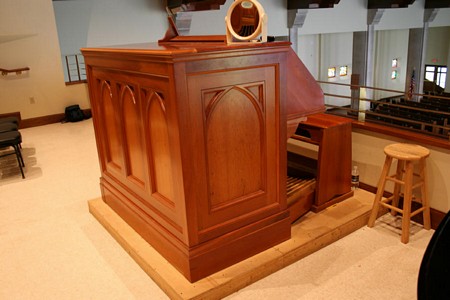 |
Pearched in the front of the spacious choir loft is the console for the organ. The console is in a fixed position mounted on a very utilitarian platform. The cables for the console come from the bottom rather than the side or back, thus the need to raise the entire console up off the floor. This solves the cable issue, but creates another issue, and that's the inability to see the choir members directly in front of the console. |
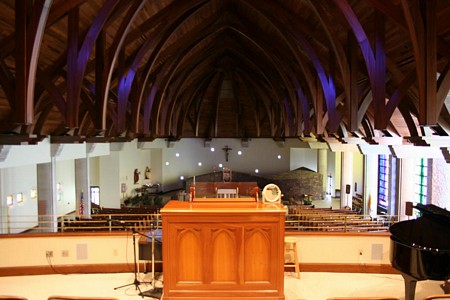 |
Here's a view from in front of the organ case looking towards the front of the church. This gives an idea of how things look from up top. The mirror on the console allows the organist to keep tabs on things going on down below. Note how the arches in the woodwork of the console match the arches in the ceiling of the church. |
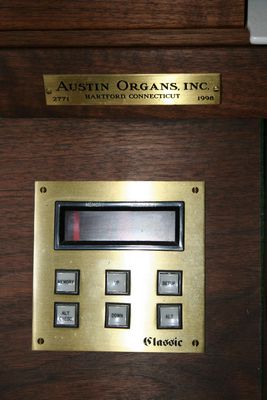 |
On the left side of the console is the name plate for the organ and a digital readout with some buttons. The name plate shows the opus number and year the organ was built. The digital readout is used for storing memory in preset stop tabs, including the crescendo. |
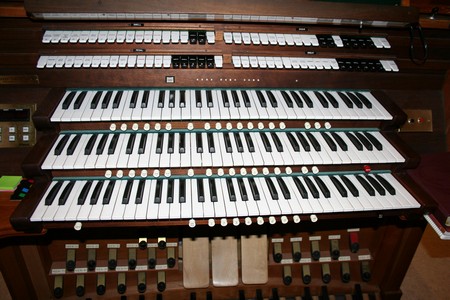 |
Here's a good view of the entire console including the digital readout on the left side. Each manual represents a division of the organ (Great, Swell, Choir), along with the Pedal down below. The black and white tabs are the stops and couplers for the pipes. The white buttons under the keys are programmable stops which can be used to change the registration of the organ at the touch of a button. |
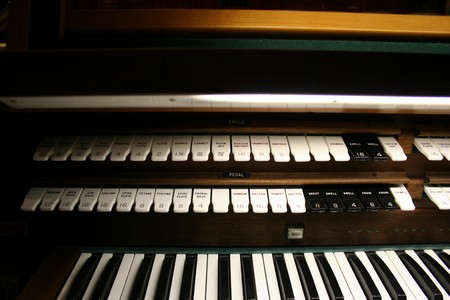 |
Here are the stop tabs on the left side of the console. Most theater organ consoles have stop tabs while a classical organ console could have stop tabs or stop knobs (or even a combination of both). This photo shows the three types of stop tab classifications on this organ. The white tabs are stops, the black tabs are couplers. Each tab has a name and a number (either ordinal or roman number). The number represents the fundamental pitch of the rank, except for mixture ranks which lists the number of ranks in the mixture. |
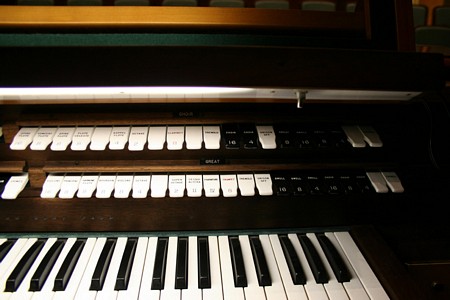 |
This is a view of the tabs on the right side. Tabs with red writing are reed stops, black writing are strings and flues. The blank tabs are place holders for prepared stops. Since the console was built thinking there were going to be eight additional ranks, there are several blank tabs. There are also a couple tabs which have writing on them but have no function. |
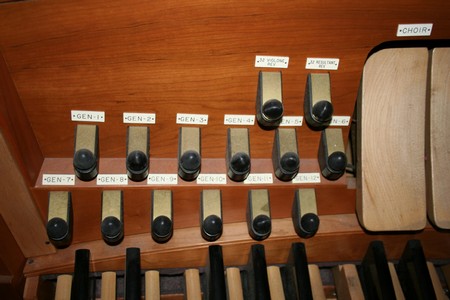 |
This is a view of what most people don't see which is the pedal board, toe studs, and expression pedals. Each of the toe studs works just like the buttons under the keys and can be programmed to change the registration. Some toe studs have been preprogrammed and are marked with their function such as the 32' Resultant Rev. |
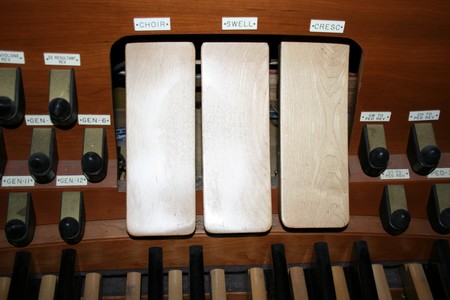 |
In
the
middle we have the expression pedals clearly marked for Choir, Swell,
and Crescendo. The further the pedal is pressed, the more sound you
get. How does a person with two feet operate three pedals? Simple -
place a foot in the middle of any two pedals next to each other, and
place the other foot on the other pedal. |
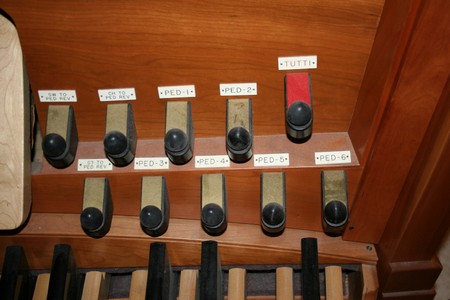 |
Here we see the toe studs specifically for the Pedal Division, as well as a prominently marked red toe stud "Tutti". This is the same as sforzando which if selected will play all principal ranks. This is also known as "full organ." It is colored red and offset from everything else as it will create quite a commotion if selected. Keeping it separated helps to prevent accidental activation. If selected, a red light will also illuminate on the console. |
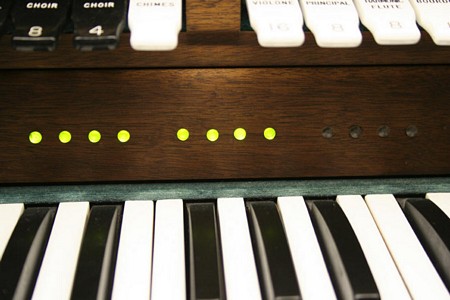 |
These three sets of lights represent how far down each expression pedal is depressed. The left is for the Choir, center for Swell, and right for Crescendo. Some organs have a much wider scale than just four lights, but some scale is better than none. In this photo, both the Choir and Swell pedals are completely depressed (shades open), and the Crescendo is not depressed at all. |
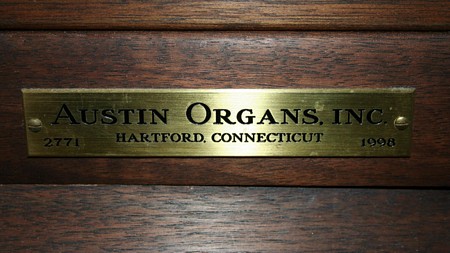 |
Austin Organs, Inc is one of the oldest organ builder in existence today having been in business since the 1890s. The builder's plate shows that this instrument is Opus 2771 built in 1998. The Austin Organs, Inc. web page has a lot of information about their company. |
| St.
Andrew Catholic Church 3/35 Austin | Main Page | Great Division | Swell Division | Choir Division | Pedal Division | Under the Pipes | Console | Facade Photos | Other Photos | Stop List |
| List of Pipe Organ Profiles | Pipe Organ Profiles Home | N8RRB Home | E-mail the Webmaster |